Kostenloser Versand ab 35€ Bestellwert!
-
Shop
- Insights
-
Über ROMBO
- Händler
- Plektren-Finder
- Geschenkgutschein
+Kategorien
- accessories
- bass
- bass pick
- bass picks
- bass plectrum
- bass plectrums
- beginner
- bright tone
- chose guitar pick
- chose guitar picks
- chose plectrum
- chose plectrums
- CrystalBright
- Diamond
- Diamond pick
- discipline and guitar
- DIY generation
- durability pick
- durable pick
- eco
- ecoblack
- find guitar pick
- find plectrum
- fingers vs picks
- grip
- grip guitar pick
- guitar accessories
- guitar advantages
- guitar benefits
- guitar career
- guitar health
- guitar injury
- guitar learn
- guitar lesions
- guitar lesson
- guitar method
- guitar noise
- Guitar noise plectrum
- guitar pain
- guitar pick
- guitar pick beginner
- guitar pick bevel
- guitar pick buy
- Guitar pick diamond
- guitar pick durability
- guitar pick durable
- guitar pick eco
- guitar pick features
- guitar pick grip
- guitar pick material
- Guitar Pick Noise
- Guitar Pick online
- guitar pick recycled
- guitar pick recycled material
- guitar pick special features
- guitar pick textures
- guitar pick thickness
- guitar pick variable thickness
- guitar picks
- guitar tone
- guitar warm-up
- guitarpick
- guitarpicks
- hold a guitar pick
- hold guitar pick
- hold guitar picks
- hold pick
- hold plectrum
- hold plectrums
- how to
- how to chose your guitar picks
- jazziii
- learn guitar
- lose guitar pick
- material
- materials
- mental health and guitar
- motivation and guitar
- music
- not to lose guitar pick
- Online guitar
- online guitar pick
- online guitar pick buy
- pick
- pick durability
- pick material
- pick noise
- Picks
- picks vs. fingers
- play bass fingers
- play bass picks
- play bass with fingers
- play bass with pick
- play bass with picks
- play bass with plectrum
- play guitar faster
- plectrum
- plectrum attributes
- plectrum beginner
- plectrum bevel
- plectrum characteristics
- plectrum features
- plectrum grip
- plectrum material
- plectrum noise
- plectrum recycled
- plectrum shape
- plectrum variable thickness
- plectrums
- Plek
- pua
- recycled
- recycled guita pick material
- recycled guitar picks
- recycled picks
- recycled plectrum
- Rombo Diamond
- rombopicks
- tendonitis guitar
- the guitar pick
- tone
- variable thickness
- warm tone
- warm-up guitar

Understanding Guitar Pick Grip: Essentials
The grip of a guitar pick is one of the most controversial topics when it comes to guitars.
Different materials or shapes of guitar picks make this topic as interesting as confusing to many guitar players.
Everyone is different and everyone plays differently. However, we (guitarists) have the same goal in this area: have a decent guitar pick grip and play as comfortably as possible.

1. What is Guitar Pick Grip?
Grip is defined as “a firm strong hold”.
The grip of a guitar pick should be good enough to avoid the slipping of the pick, the turning of the pick, or (worst case!) the dropping of the pick. In addition, it should be able to give you enough flexibility and freedom to change the position of the pick when needed.
The grip is mainly caused by the material and the texture of the surface. Nevertheless, there are other aspects like overall size or 3D geometries that can substantially increase how firmly a guitar pick can be held.

2. Advantages of Guitar Picks with high Grip
Guitar picks with a high grip can help to keep your pick from slipping. These guitar picks “stick” to your fingers even when you play aggressive guitar techniques.
They are also known for providing a feeling of secure hold and control. Your hand will need less tension to hold the pick and this will help to relax your muscles.
We have already discussed how important it is to have relaxed muscles when practicing guitar in our article “7 easy warm ups every guitar player should know”.

The biggest advantage is their usage in live performances, where control and security is essential to play correctly every chord. However, they can still drop and get (instantly) lost. Therefore we suggest having a couple of extra picks with quick access somewhere on the stage or to use a Guitar Pick Holder.
3. Disadvantages of Guitar Picks with high Grip
Although guitar picks with high grip feel very secure, this feature often comes with some disadvantages. The aggressive grip surface can feel uncomfortable or even damage your skin. This is a common problem for professional guitarists training over 2 hours a day.
The high grip sticks to the fingers and this eliminates some of the freedom you have when moving your pick on purpose, for example when you change its position to execute pick slides or harmonic pinches.
4. Types of Grip Textures on Guitar Picks
Depending on the type of guitar you play, your music style and techniques, or how sweaty your hands are when you play the guitar, you will need a different type of grip texture.
These are the most common grip textures on guitar picks:

Guitar Picks with Sandpaper Grip:
Maximum grip. Very aggressive texture. Can be uncomfortable for long playing sessions.
Guitar Picks with raised Geometries or Logos:
High grip. Aggressive texture. Can feel uncomfortable for long playing sessions.
Guitar Picks with Micronodules Texture:
Medium grip. Comfortable texture and adequate for long playing sessions.
More information about this grip texture can be found here.
Grip Holes or deepened Geometries:
Medium grip. Sometimes uncomfortable when holding the pick very tight.
Homemade Guitar Pick Grip:
Some players use tape or make scratches on the pick surface to create a custom experience.
5. Less common Ways to increase Grip on Guitar Picks
As mentioned before, not only material and textures can create grip on guitar picks. There are two factors that are usually unknown and can be very helpful to increase the grip.
Using Guitar Picks with 3D Geometries on the Hold Area:
3D geometries are an underestimated way to increase grip on guitar picks. The concave and convex surfaces will create a very defined position of the guitar pick and avoid the turning of the pick without the drawbacks of aggressive textures.
In addition, correctly tilted surfaces will use your fingers as support or pivots when moving the pick on purpose.
At Rombo, we believe this is the future of guitar picks and we are increasing our efforts in this area.
One very visible example of this is Rombo Crisp.

Using a larger Guitar Pick:
The shape and size of a guitar pick are essential to increase the grip. The larger the surface, the more contact it will have with your fingers, and therefore the more friction it will create.
The best example for this are bass players that use picks. The strings of the bass are very thick and with every impact, the pick must be held very firmly. Most bass players use big sized triangle picks or teardrop picks with enough surface on the body.

Holding your Guitar Pick right:
This is an external factor and not intrinsically dependent on the guitar pick. However, I decided to include it because of the number of players having trouble with this issue and not being aware of it.

If you feel you cannot hold the guitar pick firmly and some techniques make the pick slip or drop, you should question how you hold a guitar pick before you question the grip provided by the pick.
For these people, we created an article called “How to hold a guitar pick”, which can be found here.
6. Guitar pick Grip at Rombo
The absolute guitar pick grip of our picks is determined by four factors:
- Material
- Micronodules grip textures
- 3D geometries
- Variable thickness
The combination of these factors creates a medium-high grip, which is still comfortable enough for long playing sessions and adequate for live performances.

When developing the grip, our focus was to create a type of grip which allows the player to keep enough flexibility and freedom, as well as providing a high feeling of security and control.
With the material, we made no compromises and chose a very improved version of nylon manufactured in Italy. We have discussed its properties here.
7. The adequate Guitar Pick Grip for you
It is up to you to find a balance between comfort and grip. Some players prefer non-sticky guitar picks, others need the maximum grip available.
Depending on your playing style, your hours of practice, and the environment (solo, studio, live, ...), you might need different guitar pick grips for different occasions.

Personally, I put comfort at the top of my priorities when it comes to guitar playing. Once I get used to a guitar pick, the grip is a secondary aspect to take into account. If I choose a comfortable holding I can put my attention on other aspects like tone or attack.
8. Conclusion and last Thoughts
There are many different levels of guitar pick grip depending on the material, the textures, the size, and other secondary aspects.
The greatest guitar players use different picks for different occasions or instruments, and we recommend having at least 3 favorite guitar picks to vary things like tone, attack, grip or flexibility, and become a more versatile guitar player with the ability to adapt yourself to different environments.
Choosing the right guitar pick grip is a journey every guitar player will experience. I hope you enjoy the journey and try lots of different and interesting types of guitar picks!


10 Lösungen gegen schwitzige Hände beim Gitarre spielen
Verschwitzte Handflächen oder verschwitzte Hände sind eines der häufigsten Probleme, unter denen Gitarristen leiden.
Das Spielen mit nassen Händen erschwert einige Techniken wie Bendings und Slides können etwas knifflig werden.
Nicht nur wird dein Spiel kann durch Schweiß beeinträchtigt werden, aber auch deine Gitarre: Die im Schweiß enthaltenen Salze fressen die Saiten auf und können sogar den Hals der Gitarre beschädigen.

Wenn du dieses Problem häufig hast, kennst du das Gefühl von vermindertem Halt, unpräzisen Bewegungen und mangelnder Kontrolle beim Gitarre spielen. Das kann zu frustrierenden Momenten führen und im schlimmsten Fall dazu, dass man für immer mit dem Gitarre spielen aufhört.
Trotzdem haben wir zwei gute Nachrichten für dich:
Du bist nicht allein: Schwitzende Hände sind ein Problem, das fast 10 % der Gitarristen betrifft.
Schwitzige Hände hindern dich nicht daran, ein exzellenter Gitarrist zu werden. Es gibt viele Lösungen.
Wir haben unsere Arbeit getan und mit vielen Experten gesprochen, um die Top 10 Möglichkeiten zusammenzufassen, wie man schwitzende Hände beim Gitarre spielen vermeidet.
Tipp 1 – Entspannen und beruhigen:
Der häufigste Grund für das Schwitzen beim Gitarre spielen ist Nervosität. Besonders bei Live-Auftritten oder während Studioaufnahmen.
Zu Hause bist du in einer kontrollierten Umgebung und kannst die Anspannung deines Körpers leichter abbauen, Du kannst dir Zeit nehmen und bei Fehlern wieder von vorne beginnen.

Einige Gitarrenschüler haben berichtet, dass sie nur während des Gitarrenunterrichts oder der Proben schwitzige Hände haben.
Wenn dies bei dir der Fall ist, atme ein paar Mal tief durch und wärme dich auf, bevor du Gitarre spielst. Versuche zu lernen, wie du diese Situation kontrollieren kannst, und verstehen, dass es nur mental ist. Viel Glück damit!
Tipp 2 - Kaltes Wasser und Seife:
In Kombination mit dem ersten Tipp kann das Händewaschen mit kaltem Wasser und Seife vor dem Gitarre spielen sehr gut funktionieren.
Seife entfernt abgestorbene Hautzellen und trägt Öle und Schmutz ab, sodass du deine Gitarre auch vor Schmutz schützt, insbesondere die Gitarrensaiten.

Tipp 3 - Spiele an einem trockenen Ort:
Auch in den wärmsten Monaten kann die Suche nach einem trockenen Ort zum Gitarre spielen viel gegen Schweiß helfen.

Eine Möglichkeit, die Luftfeuchtigkeit zu reduzieren, ist der Einsatz von Klimaanlagen. Andere alternative Möglichkeiten, einen Raum trocken zu halten, sind Pflanzen im Raum, die Feuchtigkeit absorbieren, oder die Verwendung eines Luftentfeuchters.
Tipp 4 - Verwende einen Ventilator:
Die Verwendung eines Ventilators, der auf deine Gitarre zeigt, hilft dabei, deinen Schweiß zu verdunsten und hält deine Hände kühler, sodass sie weniger schwitzen.
Der größte Nachteil dieser Lösung ist die Geräuschentwicklung des Lüfters. Gerade wenn du zu Hause spielst und dich entspannen möchten, kann das Geräusch eines Lüfters auch beim E-Gitarre spielen störend sein.
Tipp 5 - Verwende ein Handtuch zwischen den Songs:
So wie du deine Gitarre zwischen den Liedern stimmst, solltest du auch deine Hände abtrocknen und die Saiten nach jedem Lied und nach dem Spielen abwischen.

Schweiß ist ein Killer für Gitarrensaiten, und manche Leute haben sehr sauren Schweiß, der die Gitarre und die Saiten noch schneller beschädigt.
Bewahre ein Handtuch auf dem Gitarrenkoffer auf, und nach ein paar Sessions wirst du nicht einmal bemerken, dass du deine Hände instinktiv abtrocknest.
Tipp 6 – Babypuder:
Babypuder, auch Talkumpuder genannt, ist ein tolles Hausmittel gegen schwitzende Hände beim Gitarre spielen. Es ist einfach, schnell und effektiv.
Viele große Gitarristen haben diese Methode über Jahrzehnte angewandt und sogar eine kleine Flasche Talkumpuder für jeden Auftritt dabei.
Tipp 7 - Kletterkreide:
Um sicher in deinem Gitarrenspiel zu sein, solltest du auf deine schwitzigen Hände achten und dafür sorgen, dass sie trocken bleiben.
Wenn das Talkumpuder nicht funktioniert hat, solltest du dich nach professioneller Kletterkreide umsehen.
Tipp 8 – Bleib hydriert:
Hydratisiert zu bleiben hilft dir nicht nur dabei, deine Körpertemperatur zu kontrollieren und lässt dich weniger schwitzen, sondern auch gesünder schwitzen. Was meine ich damit?

Wenn dein Körper dehydriert ist, steigt die Natriumkonzentration im Schweiß, welche einen höheren pH-Wert erzeugt.
Saurer Schweiß ist sehr klebrig und unangenehm beim Spielen, er beschädigt deine Gitarre und korrodiert die Saiten noch schneller.
Tipp 9 – Verwende das richtige Finish für das Holz des Gitarrenhalses:
Gitarrenhälse werden aus vielen verschiedenen Holzarten und Holzoberflächen hergestellt. Zum Beispiel lackiertes oder unbehandeltes Holz .

Bring deine Gitarre zu einem Gitarrenbauer und sprich mit ihm über dein Problem. Er wird dir das beste Finish für deinen Hauttyp und deinen Spielstil empfehlen und du erhöhst die Chance, eine praktikable Lösung zu finden.
Tipp 10 – Besuche den Dermatologen:
Die Hände aller schwitzen. Wenn du viele Methoden zur Verringerung des Schweißes beim Gitarrenspielen getestet hast und sie dir die Freude am Spielen nehmen oder deine Technik beeinträchtigen, solltest du einen Dermatologen aufsuchen und prüfen, ob du an Hyperhidrose leidest. Von dieser Erkrankung sind nur 2,8 % der Weltbevölkerung betroffen.
Dermatologen arbeiten jeden Tag mit vergleichbaren Patienten und wissen, was zu tun ist, damit du wieder unbesorgt Gitarre spielen kannst.
Bonus: Tipp 11 – Wenn deine Spielhand schwitzt, finde ein ein geeignetes Plektrum
Manchmal ist der beste Ausgangspunkt ein Variety Pack mit verschiedenen Plektren.

Letzte Gedanken:
Du bist nicht allein. Sprich mit anderen Gitarristen, teile deine Lösungen mit ihnen und helft einander. Der Lernweg des Gitarristen ist ein Weg voller Hindernisse und schwitzende Hände sind nur eines davon.
Sprich mit deinem Gitarrenlehrer und teile ihm oder ihr dein Problem mit. Wahrscheinlich werden sie auch einige andere Schüler mit dem gleichen Problem gehabt haben.
Bitte teile uns mit, ob du eine noch bessere Methode gefunden hast, um das Schwitzen der Hände beim Gitarrenspielen zu verhindern, damit wir sie in diesen Artikel aufnehmen können. Danke!

New guitar picks for 2021 - How over 1500 guitar players helped us co-design our guitar picks:
In May 2020, Judith and I had finished the first 3D sketches of our four new guitar pick models. However, the picks weren’t 100% ready.
The thickness, the size, and even the names of the picks were still undefined.

We decided to take a new approach and involve as many guitarists as possible to help us co-create our new guitar picks.
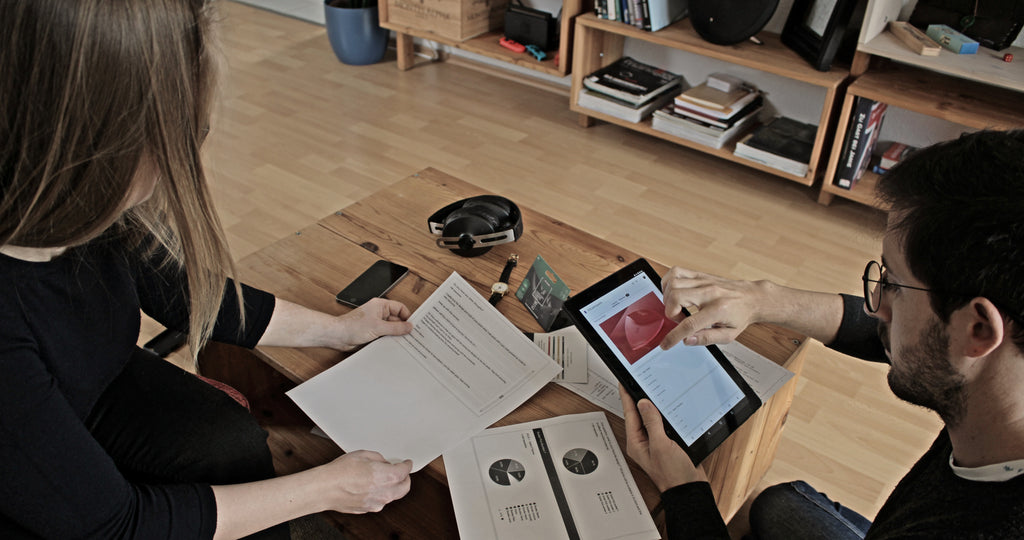
What is a signature guitar pick:
Signature guitar picks are common in the guitar pick world.
These picks were developed with the help of some expert and famous guitarists from a specific music field.
From our point of view, this is a very narrow design path that only considers the opinion and guitar playing style of one person.
Our approach: The opposite of a signature pick:
The guitar community has strongly supported Rombopicks since its beginning in 2019.
We did not want to create new guitar picks without asking the people who have been with us since the beginning. You guys and girls are the core of Rombo, and you should decide which products we develop.
The most logical step was to create a big survey to allow users to tell us how they prefer their guitar picks.
We think this is the only way to develop our guitar picks, based on the wants of our users, allowing us to make essential decisions about our company's direction.

This is only possible by listening to the thoughts of every guitar player.
In addition, by asking precise questions about guitar picks, we are able to create more awareness of complex issues, like: Why are guitar picks thick or thin? How they behave when the size changes? Does the flexibility of a guitar pick affect the tone? What about the material?
When the user is aware of the product features, he/she can deliver a useful vote.
Since the beginning, we have been researching all these areas and are sharing them with you. With every article about plectrums we have written, we have contributed to the knowledge you have about your gear so you will be able to decide which gear is the best for you and understand why.
The results of the survey:
Participants:
1.552 guitar players (including us) have participated in the survey and therefore have took part in the design process of these new guitar picks for 2021.
336 of them left a private message with detailed information.

What is your favorite guitar pick design?
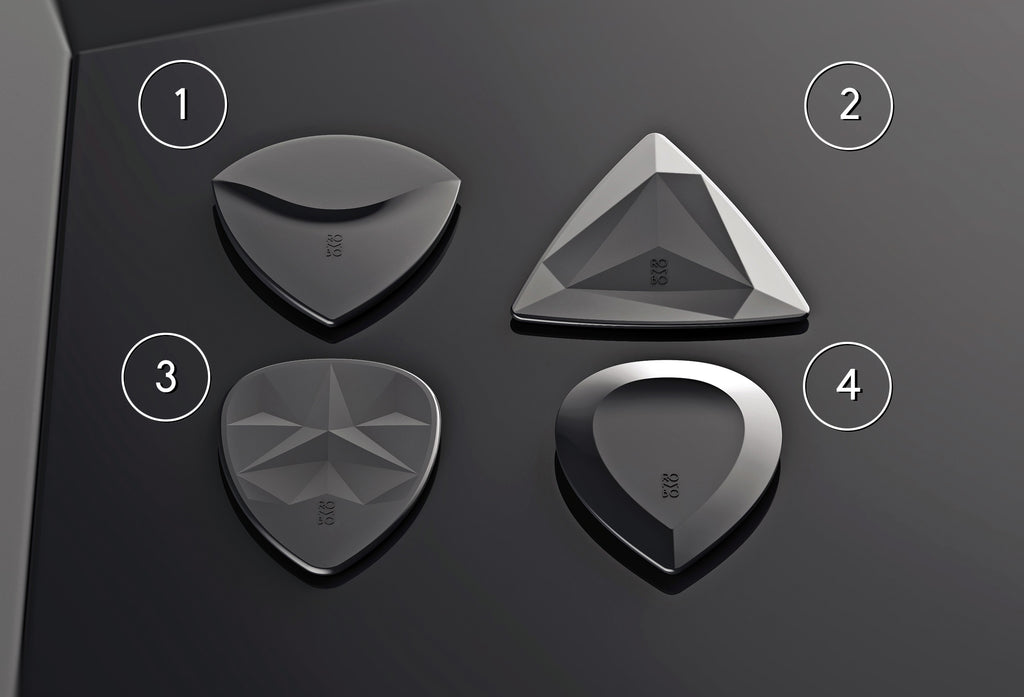
Pick number1: 18,8%
Pick number 2: 14,8%
Pick number 3: 27,8%
Pick number 4: 38,7%
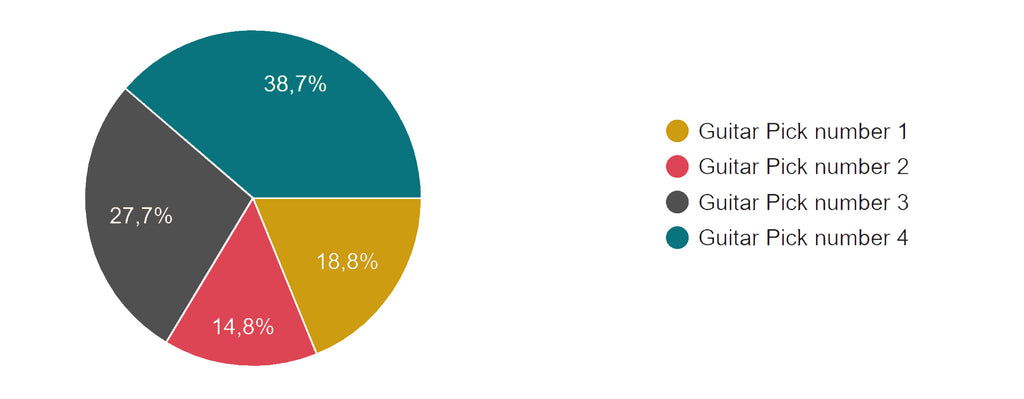
Guitar Pick Number 1:

Name:
Rombo Horizon: 34,5%
Rombo Sense. 33,9%
Rombo Summit: 14,1%
Rombo Mood: 7%
Other names: 10,5%
Average Thickness: 1,378 mm
Average Size: Medium Size with 71% of the votes
Guitar Pick Number 2:

Name:
Rombo Prisma: 76%
Rombo Spin: 7,7%
Rombo Treble: 8,4%
Other names: 7,9%
Average Thickness: 0,831 mm
Average Size: Large Size with 73,5% of the votes
Guitar Pick Number 3:

Name:
Rombo Crisp: 47%
Rombo Split: 22,1%
Rombo Prisma: 16,4%
Other names: 14,5%
Average Thickness: 1,028 mm
Average Size: Medium Size with 59,7% of the votes
Guitar Pick Number 4:

Name:
Rombo Jade: 33%
Rombo Shift: 17,6%
Rombo Slope: 12%
Rombo Summit: 10%
Rombo Dune: 7%
Rombo Cascade: 7%
Rombo Wizzard: 4,9%
Other names: 8,5%
Average Thickness: 2,37 mm
Average Size: Small Size with 56,6% of the votes
Guitar picks: Personal thoughts of 336 guitar players

A total of 336 people left us a private message regarding guitar picks.
We have read all of them carefully and we will use all this information during the development.
Here are the important questions we have received and our comments to them:
-
Will the guitar picks be available in new colors?
Not at the moment. However, we are thinking about creating some additional colors for special editions in the future.
-
Will they have the same grip structure?
Yes! Definitely. Lots of people have sent us e-mails and letters regarding the grip structure. With the micro-nodules, we have the advantage of medium-grip surfaces which add lots of control.
However, a very small number of people want the picks to have more grip. We had to make a decision here, and it was hard.
We won’t forget this topic: In the future, we want to develop a texture with more grip for these players.
-
Why don’t you create different guitar pick thicknesses for each one of the models?
We want every guitar pick to be unique. As every person has unique preferences, we believe every guitar pick should have its own design.
In the future, we hope to be able to create a bigger quantity of different plectrum designs to cover each possible necessity.
-
What about picks for bass players?
Most our picks are compatible with bass, as we have confirmed this with some bassists that are using them regularly, especially Rombo Diamond ad Rombo Origami. We explained this HERE.
-
You should create some merch, T-Shirts and other stuff:
Maybe in the future. Now, we want to focus 100% on the development of the guitar picks. Every minute we spend on the design of a T-Shirt will be taken away from the quality of the picks! ;)
-
Will you offer the EcoBlack range in other colors?
The EcoBlack material can only be produced in one color at the moment. The recycling process creates a very dark pigmentation. The industry is working hard to find a way to create new recycling processes. We hope we will manufacture all of our picks out of recycled material in the future.
When will be the new picks available?

The new guitar picks will be available in early 2021.
If you want to receive an E-Mail as soon as the picks are availabe, join our mailing list below on the footer.
This is the timeline we created for this project:

The pre-order product launch will be on the platform Kickstarter (like the first generation of Rombo guitar picks we launched in January 2019).
However, the current development of the Covid-19 could postpone the project a couple of months. We want to launch the product when we are able to deliver worldwide.
Why Kickstarter?
Kickstarter campaigns turn dreams and ideas into reality. Rombo is still a small start-up run by two people, and with limited access to resources. Through Kickstarter, we involve the community of guitar players, showing our guitar picks before launching.
This process brings us in contact with the real guitar players and their necessities. It forces us to remain flexible, accept changes, and challenges us to create new designs to fulfill the expectations of our audience.
We love open and critical criticism, and this is the best place to get it, where all comments and thoughts are visible. By sharing your experiences, we can listen to your needs and wishes, and create guitar picks that make a difference.

Guitar Pick Materials At Rombo
Guitar picks can really be made out of anything. In the past, some exotic materials were used to produce guitar picks.
The technological wave that came with highly specialized polymers created a new era of materials with amazing properties.
How The Material Of A Guitar Pick Influences Your Playing
The material of a guitar pick is strictly connected to its flexibility and tone. It is hard to imagine that such a small piece can have a big impact on playability.
However, you will clearly notice some sound differences when testing a couple of different guitar picks.
Luckily, these small useful gems are the cheapest guitar accessory you can acquire, allowing you to test many guitar pick models.

The Constant Search For The Perfect Tone
When it comes to guitar picks, changing the properties of a material is not an easy task.
Flexible guitar pick materials:
Flexible guitar pick materials can create mellow and warm tones when using specific guitar techniques. However, they can also achieve brighter tones when holding the pick very closely to the pointy tip or “attack area”. This is the reason they have been the go-to choice for guitarists for decades.
Stiff guitar pick materials:
Stiff guitar pick materials can create a snappier, bright tone that can be very delightful, provide more volume and more clarity to your chords and solo notes. These picks are often used for more specific guitar techniques by lead guitarists.
Material Isn't Everything
Thickness, shape and size will play an important role too!
Flexible guitar pick materials can create mellow, warm tones. However, when using plectrum thicknesses over 1 mm, the tone will get darker and heavier. This can be used to create the feeling of having more “bass” in your instrument. The same effect happens with the size. The more material you have, the heavier the sound will be.


We have a guide to find your guitar pick HERE. You will learn how these 4 attributes (material, shape, size, and thickness) are connected.
Finding The Materials For Rombo Guitar Picks:
Every guitarist has different preferences. Throughout our development, we have involved as many professional guitarists as possible, and asked them to define how their perfect material should feel.
We came to the following conclusions. The guitar pick material should:
- feel nice to the touch and be comfortable, yet provide grip
- be able to create clear tones, without compromising the bass tones
- be very versatile: feel flexible when thin and feel stiff when thick
- be durable
- look nice
With these premises, we started our long journey: the search for a suitable material.
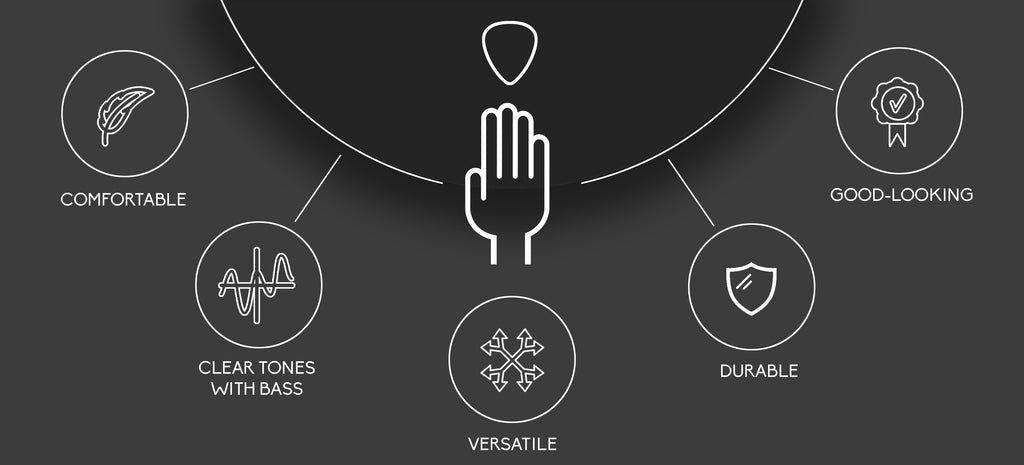
After lots of tests, feedback rounds and sending dozens of pick prototypes around the globe to our guitar pick testers, we think we`ve found it!
Guitar Pick Materials At Rombo
We are using a thermoplastic polymer that belongs to the family of the polyamides. This material is used in aerospace and automobile industries and has the following properties:
- High-mechanical strength
- Versatile (rigid or flexible -depending on the treatment and thickness)
- Excellent impact resistance (guitar strings)
- Superior aesthetic properties
- Medium / low friction
The raw material we use is produced in Italy. We have worked very closely with our material partner to accomplish every requirement we had, including the 100% recycled material of the EcoBlack sets.
We believe we have achieved an excellent balance between, sound, comfort, aesthetic properties, and durability.
Combined with well-thought ergonomic designs, different textures, and very good quality control of the process, this material can accomplish all 5 premises we defined above.


Eco-Black Range: 100% Recycled Guitar Picks
We are also experimenting with recycled materials. In our “ECO-Black" range, we offer the same material formula, but use 100% recycled material from pre-consumer waste.
In this product range, the guitar picks are only available in Graphite Black. Currently, this is the only color we can produce when using this compound.

In addition, during compound manufacturing, there are 90% less emissions, 65% energy reduction, and a 61% reduction of total resources.
We will continue our hard work in this area and someday in the future, we will be able to create colored guitar picks out of this material. When this day comes, all of our guitar picks will be 100% recycled.
Read more about the Eco-Black range and the recycled guitar picks in our article "ROMBO Unveils New “Eco-Black Range Guitar Pick Models".
Conclusion:
Finding a material you feel comfortable with is not an easy task, but you will have lots of fun along the way.
We believe material development is fundamental to ensure a future of plenty of functional, good-looking and environmentally friendly materials.
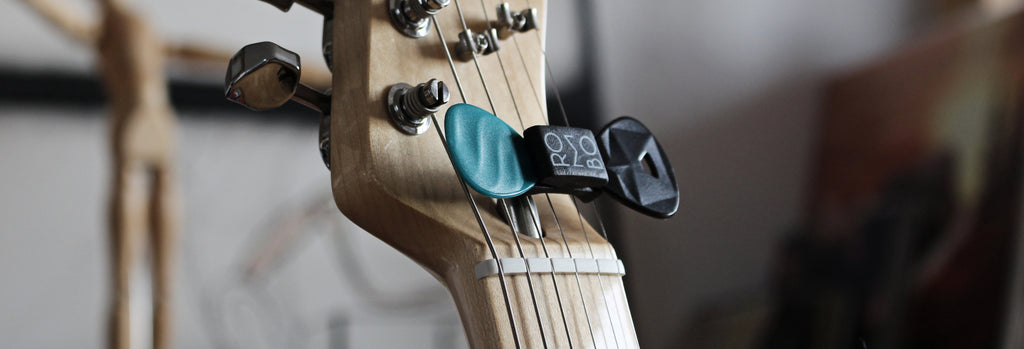
Did you find this information useful?
Share this article with friends to help us with our mission: vote for development, for the implementation of new ideas and for questioning deep-rooted standards to find something better.
Thank you!

6 Underrated Features Of A Guitar pick
In our article “How to choose the right guitar pick”, I summarized the aspects you should care about and consider when deciding which plectrum to use.
In this article, we will discuss the characteristics of a guitar pick we must pay attention to in order to make the playing experience much more comfortable and obtain better results. These aspects are not as obvious as others but are essential to get the most out of this incredible musical instrument.

1- Guitar Picks with Micronodules Grip Structure:
Grippy, non-sticky surfaces are perfect for the hold area on a guitar pick. The best way to achieve this is to create a texture, that fits between the grooves of your skin and prevents the guitar pick from slipping or creating an aggressive grip geometry that hurts the fingers of the guitarist.

2- High Mirror Polished Tip:
A guitar pick with a polished tip allows you to experience better control and less friction. In this way, reduced friction between the plectrum and the strings of the guitar will help increase the durability of the pick because it will wear less and reduce its noise.

3- Variable Thickness:
One of the less common characteristics in guitar picks is variable thickness. It is ideal for the guitar pick to be thick for better control; however, this could significantly reduce its flexibility.
For that reason, plectrums of variable thickness have been created, since this would give us the best of both aspects.
That is to say, we could have a guitar pick with a solid, thick body that gives us better grip. Additionally, it features a thinner tip that provides enough flexibility to achieve greater versatility when developing different guitar techniques.

Read more about the advantages of using a guitar pick with variable thickness in our article "5 advantages of a guitar pick with variable thickness"
4- Ergonomic Design Surfaces:
By following ergonomic models, the surface of the pick can be adapted to be comfortable, provide well-being and does not hurt the guitarist's fingers. It is advisable to look for picks with a 3D surface (those that are not flat) that have geometric patterns that offer a pleasant feeling to the grip. Similarly, we can take advantage of concave or convex surfaces, as they help keep the position of the plectrum oriented and avoid losing control in turning movements.
5- High-quality materials:
If your hands do an arduous job, then you must give them the right tools, right? Many people spend a lot of money on fancy guitars, cables, amplifiers, and other accessories but set aside the pick. This is a big mistake.
The material with which it is made can influence the definition of tone, attack, and flexibility. Therefore, without paying attention to it, you could hardly find your personal sound.
Are you curious about the materials used for the Rombo guitar picks?
Read a full article about it here:
https://rombopicks.com/blogs/insight-rombo/guitar-pick-materials-at-rombo
6- Unique Designs:
If you want to project an image with your own style, you must pay close attention to the design of your implements. To do this, you can try all the shapes and colors of guitar picks available in the market. Just imagine having one with an incredible appearance that is also very functional.

Conclusion:
In short, all aspects are subjective and depend on each person. Nevertheless, knowing such valuable information can expand our possibilities and options to choose the guitar pick that best suits our needs.
Tell us if you think this data can help you during the learning process of playing guitar and let us know if there are any other details about guitar picks that you think we should consider.
PS: Remember, you should share your skills with the world. In the article, “MUSIC AND DIY GENERATION”, I explain how the Internet community of guitarists helped me understand the importance of sharing my work.
Folge uns
Judith Heindorf & Carlos Diez Macia GbR
Auf der Steige 29
71686 Remseck am Neckar
DEUTSCHLAND
- Shop
- Händler
- Impressum
- AGB
- Widerrufsrecht
- Versandbedingungen
- Datenschutzerklärung
- Kontakt
- Presse
- Fragen & Antworten
Melde dich zu unserem Newsletter an und erhalte alle Neuigkeiten zu Sales, Neuerscheinungen und vielem mehr…
Mit der Anmeldung stimmst du unseren Datenschutzbedingungen zu.
© 2025 ROMBO.
ist eine registrierte EU-Marke.
Wir nutzen Shopify.

